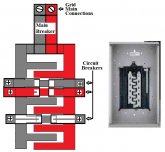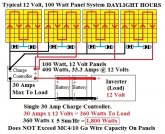Hi all,
I am new to all this, learning so that we can use solar and wind in our future house.
I’m having trouble finding information that explains the difference between a 200 amp Service compare two solar system. Does amp hours equivalent the same thing as a 200 amp grid service? Are there any videos that showThing connecting a solar system into a 2 phase 200 amp breaker box? Would I have two separate breaker boxes one for 12v such as LED lights etc and one for outlets/fan etc?
thank you for the assistance and knowledge!!!
You are confusing terms from different disciplines in electricity...
First, the utility grid has TWO 120 Volt AC (Vac) conductors ('Hot' Wires Called 'Line 1' & 'Line 2' that when Combined produce 240 VAC.
The inside of a breaker panel looks something like this, Gray & Red represent the 120Vac 'Line 1' & 'Line 2' from the power grid.
The breakers in the drawing show how two stacked breakers provide the 240Vac to any particular device.
While a single breaker provides power to any 120Vac device.

In AC, your meter reads Watt Hours (Wh), or more often Kilo (thousand) Watt Hours (kWh).
For example, every AC appliance is *Supposed* to have a CONSUMPTION sticker, as in showing '1,500 Watts' (1.500 Watts/Hour) or it may be expressed as 1.5kWh, same consumption just a different way to express it.
A Watt is a unit of measure of energy.
1 Watt of electricity can be directly converted into 3.12 BTU of heat (British Thermal Unit) through electrical resistance.
745.7 Watts is one 'Horsepower' of mechanical energy.
So Watt Hours (Wh), often expressed as just Watts (W) is the baseline you break everything down to because it is the base measurement.
------------------------
Now you will need to break down things that are rated in Watts & Amps, or Watts & Volts.
An example:
2,000 Watt Inverter @ 120 Volts AC, Watts Divided By Volts = Amps (Amp Hours or Ah)
2,000Wh / 120Vac = 16.66Ah, or Amps per Hour.
2,000Wh / 16.66Ah = 120 Vac
The other way around,
120Vac x 16.66Ah = 1,999.2Wh
16.66Ah x 120Vac = 1,999.2Wh
Now you can figure the load on any particular circuit and convert it to Wh...
----------------------------------
When dealing with batteries it's not much different, same rules apply.
A 12 Volt DC (Vdc) that's rated for say 100Ah, 12 Volt, 100Ah
100Ah x 12 Vdc = 1,200Wh (12kWh)
12,000Wh / 12Vdc = 100Ah
1,200Wh / 100Ah = 12Vdc
Since a Watt is a Watt, from the panels to battery to inverter, it's direct measuring when reduced to Watts.
This doesn't account for conversion losses, from solar panels through charge controller,
From charge controller into batteries, and the power you must leave in the batteries so they aren't damaged.
A lead/acid 100Ah RATED battery will only provide about 25Ah without being damaged.
A LFP 100Ah RATED battery will produce about 80Ah without being damaged.
From batteries through inverter, all have losses in the conversion process from volts to amps, from DC to AC.
---------------------------------------------
Panels in SERIES drives up Voltage. (amperage remains the same base number)
Example would be 100Wh, 12Vdc panels.
100Wh / 12Vdc = 8.33 Amps
In
SERIES, this would produce
48 Volts, but the Ah would stay at 8.33
Panels in PARALLEL drives up Amperage. (Voltage remains the same base number)
100Wh / 12Vdc = 8.33 Amps
In
PARALLEL, this would produce 12 Volts, but the
Amperage would jump to 33.32.
You can also split the difference, 2 panels in Series for 24 Volts x2 (4 panels total),
Then Parallel the two Series strings for 16.66 Amps.
An Example:
Panels that use MC4 connectors that are rated for 20 Amps, this keeps you under the 20 Amp limit with exactly the same power being conducted.
Two panels in Series for 24 Volts, Two Parallel sets of lines into the charge controller.
The 2 batteries are in Parallel.






